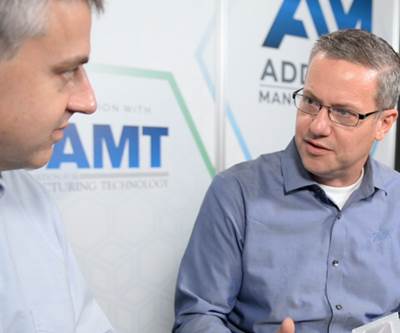Video: The Pella Corporation Is Succeeding With 3D-Printed Tooling
An engineering leader with the window and door maker shows examples of the tooling and machine parts now produced for the company's manufacturing processes using 3D printing.
Window and door maker Pella improved its ability to solve manufacturing problems thanks to additive manufacturing. Two 3D printers from Plural Additive Manufacturing now run almost continuously to supply this company's manufacturing plants with custom tooling and special machine parts aimed at improving and refining its processes. I recently spoke with Pella Senior Engineering Team Leader Kurtis Webb about this. Also visible in this video is Ed Israel, president of Plural. See him speak in a different segment of the video captured here. And for more from Kurtis Webb about the mindset change involved in realizing the promise of additive manufacturing at Pella, read this Q&A.
Transcript
Peter Zelinski, Additive Manufacturing
You have a piece here that illustrates the size of the build chamber and what that can get you.
Kurtis Webb, Pella Corp.
We're wanting to capture and reclaim some fluid in an application, so we've got a funnel here that's doing that for us. As you can see, it is tall and if we lay it down it’s wide but [if we build it laying down] then we are not going to get the surface finish that we really desire. Another clever thing that our designers did with this, and it's really been fun to just empower people to solve problems differently, is that when it comes time to clean [the part] that sump down in there is pretty narrow, and pretty deep and it's difficult to clean in there. So, we came up with a multi-part solution. It's a nice snug fit but it comes apart. Now, this [piece] becomes very easy to clean.
Peter Zelinski
This is a machine component for one of your pieces of manufacturing equipment?
Kurtis Webb
Yes, this is a piece of manufacturing equipment. So, this is being used in production, on a machine.
Peter Zelinski
It has to do with simply capturing some fluid and because you 3D printed it, you had the chance to iterate this design and get to the perfect fit and perfect containment of the fluid you’re trying to catch.
Kurtis Webb
Through printing it, we could do iterations faster and at a much lower cost than trying to build assemblies. There are some early iterations before we introduced 3D printing as a potential solution that were assemblies of flat plastic parts. It was very time consuming and we couldn't blend things together like we wanted to and really get the end product we wanted.
Peter Zelinski
There is one more of your parts I want to talk about because it serves the needs of assembly so well. It is the one with the transition. Superficially, it looks like kind of a simple part but there are some nuance things going on here. Why don't you talk about what that does?
Kurtis Webb
We're a made-to-order operation, so each product that's being produced has specific requirements. So, we'll bring the individual parts needed often in a kit cart or a kit tray. This part helps those parts move from the kit tray into the product. We've got a 45-degree angle here to match up with the part well. Then there's some geometry going in here to help smooth and guide that part as it transitions through. Traditionally, we would have looked at this and begun machining out of a solid block of either plastic or metal and then built up assemblies and it would've been a lot of machining and a lot of parts assembled together. But by leveraging what 3D printing can do, [we] did it in one assembly. [We were] able to get it out on the machine, try it out, figure out where we have issues and, again, the iterations could occur during the build process of the machine very rapidly.
What was interesting is as we were going through that, it was fairly early on that there was a reluctance from our machinists to say “Hey we need to reprint that,” because they were thinking in the concept of how much time and effort would have been in that part if it was machined. They were like, “Well, we can we can put it on one of the mills and we can just mill out that part off.” I said, “No, no let's just reprint it.” But, it was really a fun part.
We got a lot of different people exposed to it and understanding and it really helped transition a lot of minds in how 3D printing can work and how the iterations can work. And it's okay that this isn't used in the final one. That's one of the iterations along the way.
Read Next
3D-Printed Tooling and the Mindset Change at Pella
For the window and door maker, 3D printing for tooling and machine components is “not just another tool, but a whole other toolkit.” However, winning widespread acceptance and understanding was the most important challenge.
Read MoreThe Manufacturing Network as a Source for Internal Custom Tooling
For a tool that includes both machined and 3D-printed components, all the pieces of the tool can be made by separate companies yet arrive together. BMW has used Xometry to obtain tooling in this way.
Read MoreProfilometry-Based Indentation Plastometry (PIP) as an Alternative to Standard Tensile Testing
UK-based Plastometrex offers a benchtop testing device utilizing PIP to quickly and easily analyze the yield strength, tensile strength and uniform elongation of samples and even printed parts. The solution is particularly useful for additive manufacturing.
Read More

















